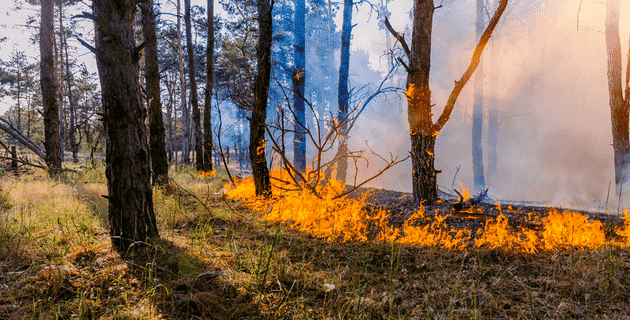When the weather is hot and dry, and conditions are just right, wildfires happen. They are more common in some parts of the country than others, but it’s important to remember a fire can break out anywhere. And when it does, your home and your family are at risk.
Know whether your home is located in a high-risk fire zone and what to do to protect it.
What’s your zone?
A fire hazard zone is a region that has characteristics that put it at higher risk for wildfires, such as:
-
- A history of fires in the region over a 30-50-year period
- Dry, hot, and windy weather that cause fires to spread faster
- Forests and vegetation that act as fuel for fire
- Steep slopes where fire often burns faster
- The potential for fires to burn through the top layer of foliage
- Burning embers that could spread to urban areas
Millions of homes are located in or near fire hazard severity zones. U.S. states most impacted by wildfires include California, Oregon, and Arizona. California has classified its fire zones as moderate, high, and very high. These areas are mapped by the California Department of Forestry and Fire Protection. The zones help property owners and builders better protect structures in areas at high risk.
Other states also affected by recent wildfires include Washington, Colorado, Montana, Wyoming, Utah, Idaho, Nevada, Texas, Alaska, New Mexico, Oklahoma, and Florida. There’s been a population boom in these drought-sensitive regions, which means there’s an increased risk of human activity sparking a fire.
The nonprofit, First Street Foundation, has an online risk factor tool where you can search for your region’s fire risk. You also can find information from your state’s Department of Forestry. If your home is in a fire hazard zone, make sure that your community is an active Firewise USA® site working with local foresters to reduce risks.
How can you protect your home?
In addition to your community working to reduce risk, there are steps you can take to help better protect your home from wildfires.
The USDA Forest Service has divided your home and property into three zones based on research into how homes ignite. Addressing each of these zones will help to reduce the risk of a fire on your property.
Immediate Zone (Less than 5 feet) – your home and the area immediately surrounding it
-
- Seal your windows and doors to reduce the risk of embers getting inside your home. (Embers are burning pieces of wood that can be carried by winds for more than a mile.)
- Use insulated glass, which can hold heat longer than standard glass.
- Avoid acrylic skylights that could melt.
- Paint decking with fireproof paint.
- Consider other fireproof materials, from siding to roofing to metal or fiber-cement doors.
- Declutter the gutter.
- Replace missing shingles on roofs, to protect against embers.
- Install 1/8-inch metal mesh screening in exterior attic vents, also to protect against embers.
- Remove any flammable materials, including leaves, plants, or stored items away from your home’s exterior walls and from under decks or porches.
- Trim branches that hang over your home.
- Consider the installation of sprinkler heads on your roof, patio, or deck.
Intermediate Zone (5-30 feet) – landscaping and hardscaping around your home
-
- Slow the spread of fire toward your home with driveways and walkways to allow a safe area for firefighters to be able to fight the fire.
- Remove flammable vegetation and replace with stones or drought-resistant plants with high water content.
- Use crushed stone or gravel rather than flammable mulches.
- Remove vegetation underneath trees that could help the trees catch fire.
- Space trees in clusters that are 18 feet between the trees’ crowns. If there’s a slope, increase that distance.
- Keep the grass mowed short, to four inches.
- Emergency vehicles need driveways that are 12 feet wide and have a vertical clearance of 15 feet. Check that your property can accommodate them.
Extended Zone (30-100 feet) – the vegetation and land that extends 30 feet past your house
-
- Keep trees at least 12 feet apart (between canopy crowns) within 30-60 feet of your home. Keep trees at least 6 feet apart within 60-100 feet of your home.
- Pick up debris and dead plant material.
- Remove vegetation that is near storage sheds or other structures.
- Make sure your home and street are clearly marked for first responders.
Finally…
- Clean your home with fire safety in mind so that you don’t accidentally cause a fire.
- Create a family disaster plan so that everyone knows what to do in the event of a fire. Make disaster preparations for your pets as well.
- Make sure you have home insurance that protects against damage caused by natural disasters such as wildfires. The right insurance provides peace of mind in the event of a fire.
This article is furnished by California Casualty, providing auto and home insurance to educators, law enforcement officers, firefighters, and nurses. Get a quote at 1.866.704.8614 or www.calcas.com.
- Graduation – When to Remove Your Child from Your Auto Policy - May 18, 2023
- How to Prevent Catalytic Converter Theft - May 17, 2023
- How Much Does Home Insurance Cost? - May 17, 2023

